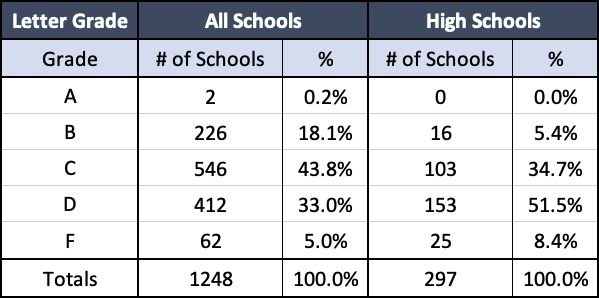Welcome to Kansas Policy Institute’s A-F Grading system for the 2023-24 school year. A-F Grading is a ‘one-stop’ destination to find out how virtually all of Kansas’s public and private schools are faring in a simple to understand format. This new addition is based on the results from the 2024 state assessments.
The 2024 A-F grading of Kansas public and private schools is now available online. The digital version has detailed information on over 1,300 public and private schools for the past four years.
Letter grading is not something you can obtain through KSDE. Despite the fact that the feds prescribe KSDE to publish a ‘report card’, the factors that make up that report card are scattered about KSDE’s website. More importantly, there is no summary of achievement at any particular school. Achievement is measured and reported in terms the “standard”, – below, meets and exceeds – vague definitions that makes it seem like KSDE is trying to hide the ball a bit.

KPI has taken the initiative to letter-grade schools. And it’s all right here. As the table shows, 1,248 schools were graded based on the 2024 state assessment. Only two schools, one public – Timber Creek Elementary (USD 229) – and one private – Brookridge Day – earned an “A”. Once again this year, no high school in the state (students are tested in the 10th grade) earned an “A”. On the other end of the scale, 62 schools received an “F”. Twenty-five of those are high schools.
The A-F Grading system is critical because it reveals the real state of performance of Kansas schools. While the state board of education and KSDE leads us to believe that “Kansas leads the world in the success of each student,” our annual presentation and analysis of state-produced data tells a much different story regarding student achievement. In a world that is increasingly distrustful of bureaucratic government information (and rightfully so), it is essential to have independent voices like KPI’s to monitor and document realities. A-F Grading continues to be one such resource.
This grading system began in 2017 and has been produced annually, save 2020 when Governor Kelly shut down the schools during the pandemic.
KPI employs state assessment results reported by KSDE and translates raw scores (which range from 220 to 380 for math and for English language arts – ELA) into letter grades. (A full methodology outline, data, and definitions is available on the A-F Grading home page.) This process gives a more concrete explanation of those results.
A-F grading on the website contains an abundance of data in addition to a school’s overall letter grade. Included are: a pin mapping system that shows the location of each school, contact information, enrollment, per-pupil spending, grade-level grades for both low-income and other students, % of low-income students and proficiency rates for both math and English language arts (ELA).
The public education landscape continues to evolve, with more school choice options available to parents in many states. Most recently, the state of Tennessee signed into law a sweeping school choice initiative allowing thousands of parents to opt for alternatives to traditional public schools.
This school choice phenomenon was bolstered by needless school closures as a response to COVID-19; thankfully few districts in Kansas stayed closed for as long as those in major cities. Nevertheless, the harm of disruptions, virtual and part-time learning, skyrocketing absenteeism and the like is still being felt and likely will be for generations.
People are hungry for a change, especially those who feel stuck in underperforming schools. But the question is, where does one go to find out how any school in the state is actually performing?
A-F Grading continues to provide opportunities to explore questions surrounding the issue of school performance. Why do some schools continue to out-perform others? Why does the education establishment continue to lobby fiercely against parental freedom to choose the best educational opportunities for their children? Why doesn’t the elected leadership at the state level recognize the sorry state of student achievement and provide those options?
.





